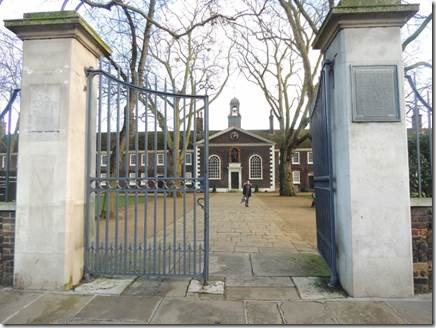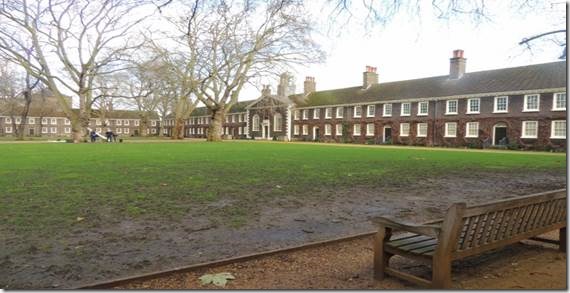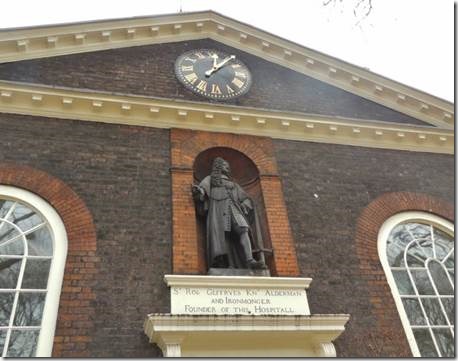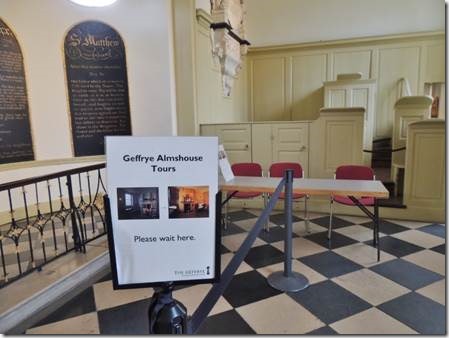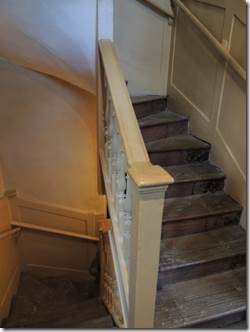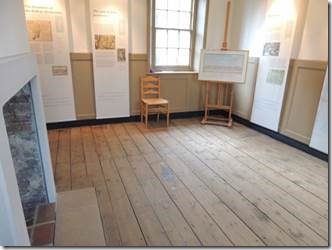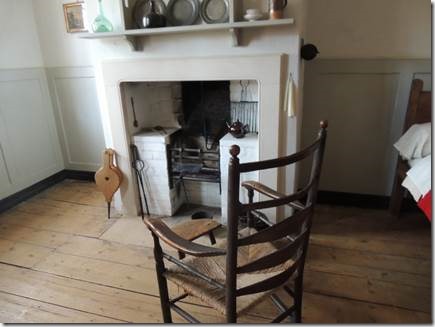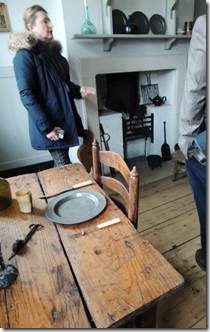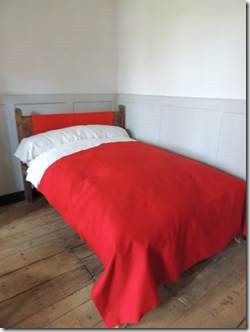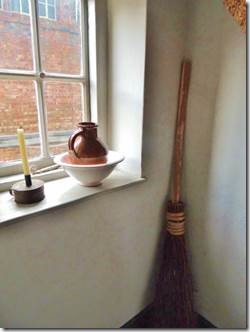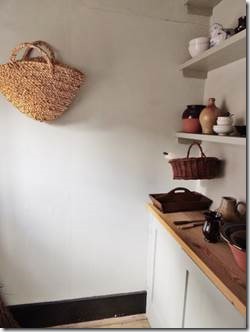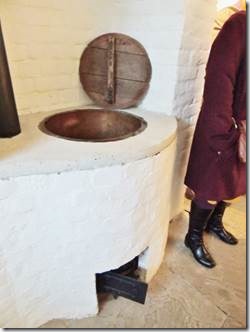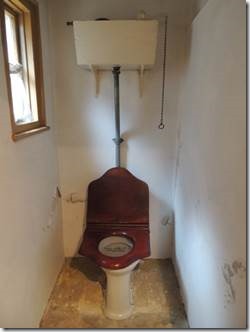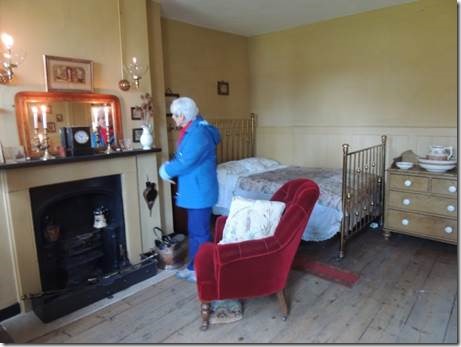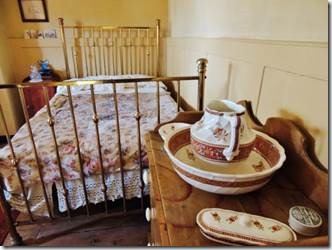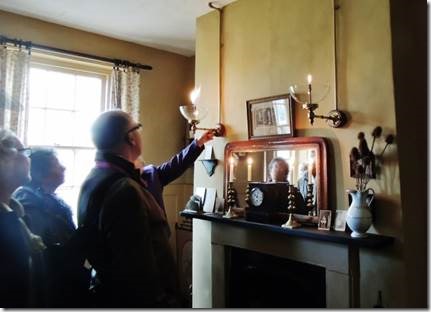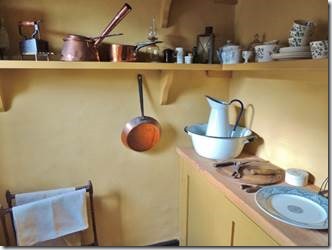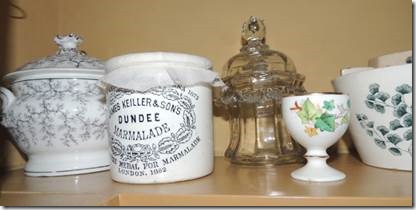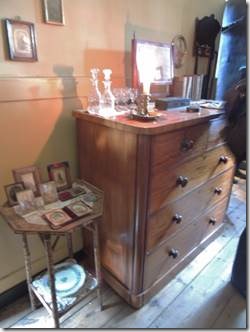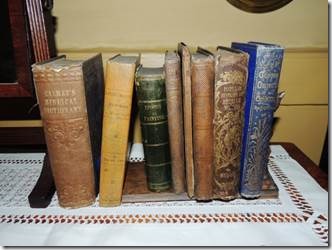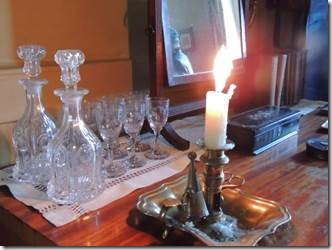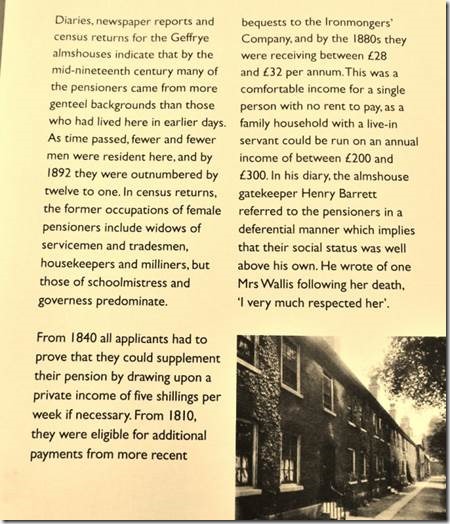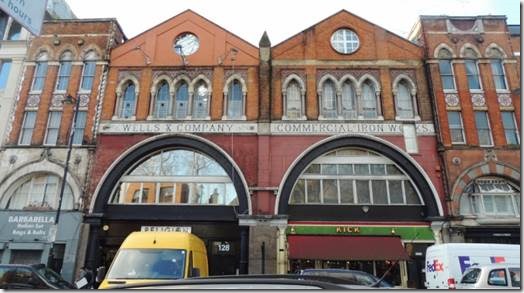Cheers,
I took myself to the Geffrye Museum. It was a total adventure as I had to take a bus for the first time by myself! Cruiser friend Sandi had told me to walk to Gracechurch Street and I could catch the 149 to the Geffrye. The Geffrey website gave me different directions and the London travel planner site gave me totally complicated directions, so I followed Sandi’s advice. I wasn’t sure where to get off the bus but by the time we got to the Geffrye stop, the driver and everyone on the bus were all telling me, “here’s your stop.”
I really enjoyed my visit, the tour, and the other people on the tour. Afterwards I even invited myself to join one of the women who was having a snack in the Geffrye cafe. She is a “horse person” so we could chat about that and about the tour. She was a recently retired teacher who, when taking her students places around London always reminded them to “look up.” That’s good advice in a place like London where there are so many architectural details on the buildings…if you just look up. Sharing a table isn’t something we do in the US but it really is quite nice.
I’d noticed an art supply shop with a half-price sale about a block from the Geffrye where I’d left the bus so, after leaving the Geffrye walked back for a new sketch notebook. As the day was bright and sunny and I could see the Gherkin off in the distance and knew the route back was pretty uncomplicated, I decided to walk. Shoreditch is quite an interesting place that might put folks off, but the main street had art shops and restaurants and I felt totally comfortable walking alone. So many places to explore.
All in all a really enjoyable day.
Ru
“Visitors to the Geffrye can view our permanent display of eleven period rooms which span approximately 400 years from around 1600 to the present day. There is also a walled herb garden and a series of four period gardens, chronologically arranged to reflect the museum’s period rooms, which can be visited between 1 April and 31 October. To the front of the museum there is a large garden facing onto Kingsland Road, which has recently been refurbished. Additionally, there is a restored 18th-century almshouse, open to visitors on selected days, which has been taken back to its original condition and provides a glimpse into the lives of London’s poor and elderly in the 1780s and 1880s.”
http://www.geffrye-museum.org.uk/period-rooms-and-gardens/
|
Entrance to the Geffrye : the woman walking in the front was our tour guide. |
|
Sir Robert Geffrye left a bequest for the almshouse |
|
“The Geffrye is set in almshouses built in 1714 by the Ironmongers’ Company, with a bequest from Sir Robert Geffrye, twice master of the Company and former Lord Mayor of London. For almost two hundred years the almshouses provided homes for around fifty poor pensioners. They are now recognised for their historic importance as Grade I listed buildings. By the early 20th century Hoxton had become one of the most overcrowded and unsavoury parts of London, and the Ironmongers’ Company decided to sell its Kingsland Road property in order to relocate the almshouses to a healthier area. The site was bought by London County Council wanting to provide public open space in such a densely populated area. Leading members of the Arts and Crafts movement petitioned the Council not to demolish the almshouses, and it was agreed to convert the buildings into a museum which opened in 1914. (Our tour guide said the London site of the Geffrye suffered no damage during WW2, but the new almshouses, moved a the less crowded area in Mottingham Kent were bombed. GEFFERY’S ALMSHOUSES, at Kingsland Road, Shoreditch (1712-1910, now the site of the Geffrye Museum), Eltham (1914-1974) and Hook, Hampshire (1974-). 1712-1915 (microfilm only 1911- 15). Ms 17053- http://www.history.ac.uk/gh/18v.htm The Battle of Britain, as it became known, was fought in the skies above Kent’s orchards, fields and villages, and it was here that Hitler’s invasion plans were first stalled, and then put off indefinitely. During the period between 12 August and 15 September 1940, wave after wave of German fighters and bombers attacked targets in Kent, and the countryside became littered with the debris of fighter aircraft from both sides. http://www.bbc.co.uk/ )
One of the almshouses, No. 14, has been restored and can now be visited. It still has most of its internal woodwork intact, including its staircase, upper floors, closets and panelling and is furnished to show the living conditions of poor pensioners in the 18th and 19th centuries. Visitors are able to compare the sparse furnishings and few personal possessions of the generally poor elderly residents of the 18th century with the rather more comfortable surroundings of the better-off pensioners of the late 19th century, and with those of middle class homes of the time in the museum’s main displays. Displays about the history of the Geffrye almshouses, philanthropic and social housing in East London and the kind of people who lived there, can be found in two further rooms and the basement. A History of the Geffrye Almshouses by Dr Kathy Haslam is available from the museum shop. |
|
Residents of the Almshouses were required to attend chapel. Waiting for the 12 noon tour. I was early and first in line; it was first come first served. The tours are only offered a few times each month with the size of the group limited to 15 people which is pushing it given the size of the rooms to be visited. I had arrived just after the 11 am tour had started so spent a bit of time looking at the museum display of furnishing from different periods of history. But my main aim was to be one of those 15 people for the almshouse tour, so by 11:40 I was waiting in this chapel to sign up and pay my 2£ 50p . By the time the tour actually started I’m sure there were a few more than 15; but everyone there really wanted to be there so no one was left behind. I’m finding as I take part in different tours around London that the folks who show up for them are usually quite nice and their questions generate more stories from the guides than one might hear otherwise. Chapel was required of the pensioners housed here. Our guide said that, especially in the 1790s most people would have been Protestant but no one was prohibited because of their religious beliefs. She also said that the Jewish community would probably have had its own provisions for the needy and I seem to remember that from our Jewish east end tour. |
|
Stairway and introductory almshouse room. “Stepping in through the double doors from the yard shaded by great trees, you find yourself in a staircase that once led to four residences on two storeys. “ http://spitalfieldslife.com/2011/05/04/at-the-geffrye-almhouses/ |
|
1780 furnishings “On the ground floor you enter the austere eighteenth century room, bare boards, lead-grey painted walls, a few unframed prints, a small dining table, a stick-back chair set by the brick range and a stump bed in the corner. Although this single room – with a tiny closet for preparing food – might have been occupied by a couple, it does not seem cramped and is comparable to, or even larger than, rooms I have visited in care homes for old people today.” http://spitalfieldslife.com/2011/05/04/at-the-geffrye-almhouses/ |
|
Our guide said that that cloths were hung over the bed to catch bugs dropping on anyone sleeping and that the mattresses were kept off the floor for that reason; avoid crawling bugs. She also explained that at that time disease wasn’t connected to bacteria and germs or the effect of soap on both so soap was looked at as a luxury and taxed making it unaffordable to most people. Later when the connection was made, the taxes were eliminated. But many pensioners lived to very old ages. |
|
The pantry where household items were kept. All residents were expected to keep the rooms clean and help with communal cleaning. In the early years there were outdoor wells and privies that had to be cleaned. But each room had a fireplace where food could be cooked and for warmth. I thought the rooms were quite charming actually as did most people on the tour. We all did appreciate the work of living with no indoor plumbing. |
|
Basement facilities A communal “washing tub” for clothes from the earliest days. The later residents shared this one communal toilet for four rooms, but I’m sure it was seen as a vast improvement over the outdoor privies. |
|
1880 furnishings “One flight of stairs above, you enter a room of the eighteen eighties and the immediate difference is that there are more things, more furniture and more trinkets. The brick range is replaced by a cast iron grate while a brass bedstead gleams in the corner – and two brackets above the fireplace carry the innovation of gaslight.” http://spitalfieldslife.com/2011/05/04/at-the-geffrye-almhouses/ |
|
Brass bed and pitcher and basin for washing now that soap was a common commodity A funny (to me) question was raised by one of the men in the tour. He wanted to know why, as by the late 1800s most residents were single, genteel women, would anyone need a bed that big. The rooms weren’t limited to single women, but the residents had to be over the age of 56 when they arrived. And by the later periods, a small rent was also charged. |
|
A demonstration of the gas lamps Each room had a large window in the main room and a small window in the pantry which I really liked. |
|
I remember buying Dundee Marmalade as a splurge as it was more expensive than Smuckers , Welches or Kroger brands. I especially like their grapefruit marmalade as well as the jars! I really wanted to pick up each item and see where it was made; but that wasn’t allowed which is probably why the stuff is still there in one piece. |
|
Glass decanters for port or sherry and books to read. What more could one want? |
|
Signs of the Ironmongers in Shoreditch 1576 THE LONDON GAZETTE, MARCH 20, 1883. The Bankruptcy Act, 1869. In the London Bankruptcy Court. In the Matter of Proceedings for Liquidation by Arrangement or Composition with Creditors, instituted by Edward Welle, late of tbe Commercial Iron Work?, Shorediteb, in the county of Middlesex, of No. 26, Queen Victoria-street, in (he city of London, now of No. 5, Dray ton Park, Islington, in tbe county of Middlesex* Iron Mercban*, James Smith, late of the Commercial Iron Works, and No. 26, Queen Victoria-street aforesaid, DOW of No. 12, Chapel-street, Milton-street; in the city of London, and Allerton Honse, South Hornsey, in tbe county of Middlesex, Iron Merchant, and Henry James Fenwick Gale, late of the Commercial Iron Works, and No. 26, Queen Victoria-street aforesaid, now of No. 12, Chapel-street aforesaid, and of Lincoln Honse, Ponder’s End, in the coutty of Middlesex, Iron Merchant, lately carrying on business in partnership together, undt-r the firm of Wells-and Company, at the Commercial Iron ^Works, and 26, Queen Victoria-street aforesaid, and as to the said James Smith and Henry James Fen-wick Gale, carrying on a separate business as Dealers in Honse Property, under the firm of Smith and Gale, at No. 12, Chapel-street aforesaid. http://www.london-gazette.co.uk/issues/25213/pages/1576/page.pdf “There are a few interesting Victorian buildings in Shoreditch that managed to survive both Hitler and 60s re-developers like this former ironworks. Shame someone cut a window through that decorative tiling.” http://shipscooksstuff.wordpress.com/2012/02/01/shoreditch-a-trip-to-londons-victorian-east-end/ “Legend has it that the name is derived from Shore’s Ditch, being the last resting place of Jane Shore the mistress of Edward IV who is supposed to have either died or been buried in a ditch in the area. What’s more likely is that the name comes from Sewer Ditch.” This blog opened with the paragraph below which I found really interesting as well as reading about his visit to Shoreditch as it was my first visit there. It’s an interesting area; I walked back from the Geffrye as I knew it was a pretty strait shot back and I could see the Gherkin and the Shard so couldn’t get too lost. My friend Brian’s studio is located in a redeveloped Victorian match factory, the Perseverance Works. This was the sort of place where the exposure to white phosphorous in the matchmaking process caused Phossy Jaw, a nasty disease that caused the teeth and jaw to rot away, before causing death from massive organ failure. The phosphorus made the affected jaw bone to glow in the dark, hence the name. The use of white phosphorus over the more expensive, but far less toxic red phosphorus was only banned in the UK in 1910, after a lot of campaigning from the Salvation Army and other philanthropic groups.” Shipscookstuff again…. |
|
While doing my reading about the Geffrye, almshouses in general, and the ironmongers, I came across the following entry from the Spitalfields Life blog. I’ve quoted it during my write up but posted it intact below as it’s a good read. |
|
“Visiting the Mariners’ almhouses at Trinity Green in Whitechapel last week filled me with curiousity to discover more of the former life of these places, and so I sought out the Geffrye almhouses in Shoreditch which are now the Geffrye Museum, where a couple of dwellings have been restored as they were once inhabited. After three centuries, the bewigged statue of Sir Robert Geffrye – the enterprising Cornishman who came to London at the age of sixteen, enjoyed a prosperous career as an ironmonger and was declared Lord Mayor of London in 1685 – still presides with a satisfied smile upon this fine terrace built in 1714 at his bequest by the Ironmongers’ Company to provide homes for “poor people of good character over the age of fifty-six.” At that time, much of the land North of Old St was given over to nurseries and market gardens, punctuated by clay pits and kilns for tile making. Quieter and healthier than the City of London, it was the ideal location for almshouses, with the Drapers Company and the Frameknitters company also building to the North and South of the Geffrye site. Built by carpenter Robert Burford, the fourteen Geffrye almhouses were constructed of good quality materials, “of oake or good yellow firr,” and “good plain tyles with heart of oak lathes,” while windows were glazed with “the best Castle (Newcastle) glass,” and each door had “a stoute lock, key and bolt and latch and good hinges.” The buildings were lacking in ostentation, with minimal ornamentation upon the interior where each dwelling consisted of a single unfurnished room of thirteen by fifteen feet. And for two hundred years, the Geffrye almhouses served their noble purpose until the rowdy city began to impinge upon the delicate sensibility of the elderly residents and, in 1908, the almshouse matron, Annie Young, complained that “All kinds of objectionable rubbish were thrown over the wall…rows between men and women were constantly to be seen…and the children who ran about the yards seemed scarcely to be human.” In 1912, the Ironmongers Company transferred their worthy pensioners to the more isolated and peaceful location of Mottingham in Kent and sold the almshouses to the London County Council who converted them into a museum of furniture, reflecting the location of Shoreditch as the centre of the furniture industry then. Yet one dwelling remained unaltered with its staircase and internal woodwork intact, in use as the museum warden’s house until 1996, and this has now been restored with one room as it might have been in 1780 and another as it might have been in 1880. Stepping in through the double doors from the yard shaded by great trees, you find yourself in a staircase that once led to four residences on two storeys. On the ground floor you enter the austere eighteenth century room, bare boards, lead-grey painted walls, a few unframed prints, a small dining table, a stick-back chair set by the brick range and a stump bed in the corner. Although this single room – with a tiny closet for preparing food – might have been occupied by a couple, it does not seem cramped and is comparable to, or even larger than, rooms I have visited in care homes for old people today. A list of residents from the seventeen eighties reveals that most were small tradesmen from London who enjoyed modest success in their working lives, and many were able to continue some form of piecework to supplement their small pensions. They were obligated to keep their rooms clean, to be in before the gates locked at night, to refrain from blasphemy or keeping poultry on the front lawn, and adultery and lewdness were both punishable by expulsion, yet the evidence of the records shows that the apparent strict regulations appear to have been followed leniently. No-one was expelled. One flight of stairs above, you enter a room of the eighteen eighties and the immediate difference is that there are more things, more furniture and more trinkets. The brick range is replaced by a cast iron grate while a brass bedstead gleams in the corner – and two brackets above the fireplace carry the innovation of gaslight. In 1898, Henry Barrett the gatekeeper recorded an incident with matron’s new gas oven, “I met with an Axedon today. There Exploded in the matron’s House the Gas. I Filled the Gas oven in the stove & I opened the Door & it exploded in my face, Burned my Face & Hair & Whiskers & Burned off my Eye Lashes. It was God’s Good Providence my Eyes was not Hurt.” Looking from the window out into the tiny courtyard where once fifty people resided in these almshouse, I could only wonder at the drama occasioned by the exploding oven in such an isolated community – where few people left except feet first and some were simply transferred direct to the ironmongers’ cemetery conveniently placed within the grounds at the end of the terrace. But in spite of the exploding ovens and rowdy neighbours, census records reveal that the Geffrye pensioners lived far beyond average life expectancy at the time – in this shangri la on the Kinsgland Rd – as Henry Barrett recorded in his journal,“Miss Daniel Died after seven years Bedrid, I think near a hundred years old.” Even today, with the steady flow of visitors and school parties to the Geffrye Museum, there is an enduring air of peace in this place that is instantly restored once the crowds have passed through the yard, and inside the almhouses you feel it pervasively, in these quiet rooms where people have sat out time.” http://spitalfieldslife.com/2011/05/04/at-the-geffrye-almhouses/ |
|
http://www.almshouses.org/almshouse-vacancies/ The Almshouse Association is a support charity representing 1,700 independent almshouse charities throughout the United Kingdom providing homes for over 35,000 people |
|
Sir Robert Geffery’s Trust Reg. Charity No. 219153 Sir Robert Geffery was twice Master of the Company and was Lord Mayor of London in 1685. Born in the village of Landrake in Cornwall, he died in London in 1704 having made his fortune in overseas trade. He left a substantial endowment for almshouses which were built in Shoreditch, east London. These were sold in 1910 to London County Council and now house the Geffrye Museum. The Company then built new almshouses at Mottingham in Kent, which in turn were sold, in 1972, to the Greater London Council. Today the Trust owns two almshouses in Hampshire, one at Hook built in 1976 and enlarged in 1987 and one at Basingstoke which was opened in 1984. These provide sheltered housing for 125 retired people of limited means. There are resident Wardens at both Homes, with the overall management carried out from Ironmongers’ Hall. Grants are made by the Trust for relief in need, focussing on educational projects for children and young people in disadvantaged areas. A bursary is given to support a student at the City of London School for Girls. http://www.ironmongers.org/company_sir_robert_gefferys_trust.htm |
|
http://www.ironmongers.org/index.htm http://www.ironmongers.org/company_livery_companies.htm explains the history of the various trade guilds and their place in British History. |
|
http://www.ironmongers.org/almshouses_gefferys_fields.htm describes the modern “almshouse” and the fee to live there. |

